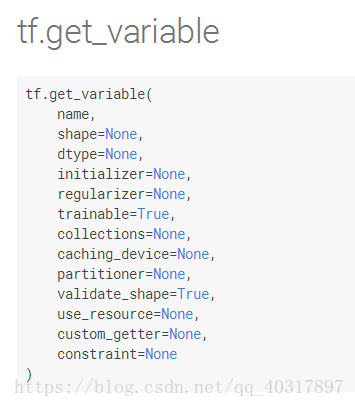问题出现在编写lstm程序时碰到两个问题始终得不到解决:
Variable rnn/multi_rnn_cell/cell_0/basic_lstm_cell/weights already exists, disallowed.
Attempt to reuse RNNCell <tensorflow.contrib.rnn.python.ops.core_rnn_cell_impl.BasicLSTMCell object at 0x000002206E714240> with a different variable scope than its first use.
其实知道这两个问题和变量的作用空间相关,但是对这个name_scope 和 variable_scope不是很理解,这两日恶补相关知识。
期间看了百度谷歌和csdn博主的答案,很多文章都没有讲到点子上,原理没搞懂,换个问题ERROR还是存在。不过也基本上知道是 get_variable() 和 variable_scope() 出了问题。
get_variable() 和 variable_scope()
要理解 name_scope 和 variable_scope, 首先必须明确二者的使用目的。我们都知道,和普通模型相比,神经网络的节点非常多,节点节点之间的连接(权值矩阵)也非常多。所以我们费尽心思,准备搭建一个网络,然后有了图1的网络,WTF! 因为变量太多,我们构造完网络之后,一看,什么鬼,这个变量到底是哪层的??
 |  |
| fig1. 引入命名空间之前 | fig2. 引入命名空间之后 |
为了解决这个问题,我们引入了 name_scope 和 variable_scope, 二者又分别承担着不同的责任:
- * name_scope: * 为了更好地管理变量的命名空间而提出的。比如在 tensorboard 中,因为引入了 name_scope, 我们的 Graph 看起来才井然有序。
- * variable_scope: * 大大大部分情况下,跟 tf.get_variable() 配合使用,实现变量共享的功能。
tf.Variable和tf.get_variable有什么区别呢?name_scope和variable_scope又有什么区别呢?下面细细说来:
首先明确tf.Variable和tf.get_variable都是获取变量的操作,其中tf.Variable的详细介绍可见这里,tf.get_variable的在这里,简要来说:

tf.Variable的name选项是选填项,可以通过name='v'的形式给出,而

tf.get_variable的name项是一个必填项,tf.get_variable会根据name去试图创建一个变量,如果在同一个scope下存在同名的变量,则程序会报错。具体例子有下面程序给出(在所有操作之前先 import tensorflow as tf):
import tensorflow as tf
# 在名字为foo的scope下创建名字为v的变量
with tf.variable_scope("foo")
v = tf.get_variable("v", [1], initializer = tf.constant_initializer(1.0))
print(v.name) # 输出foo/v:0表明这空间foo下的名为v的变量第一次输出
# 因为在foo空间内存在name = "v"的变量,则以下代码会出错
with tf.variable_scope("foo")
v = tf.get_variable("v", [1])
# 但是。如果我们想迭代调用foo下的v变量我们可以将v变量的reuse声明为True这样
# tf.get_variable函数就可以调用已经创建好了的name为v的变量了
with tf.variable_scope("foo", reuse = True)
v = tf.get_variable("v", [1])
# 我们可以验证下结果,结果输出为True,表明v和v1是指向的同一个变量
with tf.variable_scope("foo", reuse = True)
v = tf.get_variable("v", [1], initializer = tf.constant_initializer(1.0))
with tf.variable_scope("foo")
v1 = tf.get_variable("v", [1])
print(v == v1)此外,tf.variable_scope是可以嵌套的,当发生嵌套时,如果内层的reuse未指定则与外层的reuse保持一致,如果内层指定了reuse的取值,则内层的reuse根据取值而定。可以通过tf.get_variable_scope().reuse来获取当前的reuse的值:
import tensorflow as tf
with tf.variable_scope("root")
print(tf.get_variable_scope().reuse) # 输出False
with tf.variable_scope("foo", reuse = True)
print(tf.get_variable_scope().reuse) # 输出True
with tf.variable_scope("leaf", reuse = True)
print(tf.get_variable_scope().reuse) # 输出True
print(tf.get_variable_scope().reuse) # 输出True
print(tf.get_variable_scope().reuse) # 输出Falsetf.Variable的原理也是一样
import tensorflow as tf
v2 = tf.Variable([1,2], dtype=tf.float32)
print (v2.name)
v2 = tf.Variable([1,2], dtype=tf.float32, name='V')
print (v2.name)
v2 = tf.Variable([1,2], dtype=tf.float32, name='V')
print (v2.name)
print (type(v2))
print (v2)输出:
Variable:0 # 对于未命名的变量v
V:0 # 对于第一次输出name = v的变量
V_1:0 # 对于第二次输出name = v的变量
<class 'tensorflow.python.ops.variables.Variable'>
Tensor("V_1/read:0", shape=(2,), dtype=float32)从上面的实验结果来看,这两种方式所定义的变量具有相同的类型。而且只有 tf.get_variable() 创建的变量之间会发生命名冲突。在实际使用中,创建变量方式的用途也是分工非常明确的。其中
- tf.Variable() 一般变量用这种方式定义。 * 可以选择 trainable 类型 *
- tf.get_variable() 一般都是和 tf.variable_scope() 配合使用,从而实现变量共享的功能。 * 可以选择 trainable 类型 *
tf.trainable_variables()函数就不细讲了,就是我们定义的所有的 trainable=True 的所有变量以一个list的形式返回。
那么name_scope和variable_scope有什么区别呢?
import tensorflow as tf
with tf.name_scope('nsc1'):
v1 = tf.Variable([1], name='v1')
with tf.variable_scope('vsc1'):
v2 = tf.Variable([1], name='v2')
v3 = tf.get_variable(name='v3', shape=[])
print ('v1.name: ', v1.name)
print ('v2.name: ', v2.name)
print ('v3.name: ', v3.name)结果:
v1.name: nsc1/v1:0
v2.name: nsc1/vsc1/v2:0
v3.name: vsc1/v3:0从上面的例子可以看出:
1. name_scope并不会对tf.get_variable函数创建的变量进行操作
2. name_scope对tf.Variable创建的变量指定变量空间
3. tf.name_scope() 主要是用来管理命名空间的,这样子让我们的整个模型更加有条理。而 tf.variable_scope() 的作用是为了实现变量共享,它和 tf.get_variable() 来完成变量共享的功能。
这样,在构建网络的过程中我们可以使用两种方法创建变量:
第一种:使用tf.Variable
import tensorflow as tf
sess = tf.Session(config=config)
# 拿官方的例子改动一下
def my_image_filter():
conv1_weights = tf.Variable(tf.random_normal([5, 5, 32, 32]),
name="conv1_weights")
conv1_biases = tf.Variable(tf.zeros([32]), name="conv1_biases")
conv2_weights = tf.Variable(tf.random_normal([5, 5, 32, 32]),
name="conv2_weights")
conv2_biases = tf.Variable(tf.zeros([32]), name="conv2_biases")
return None
# First call creates one set of 4 variables.
result1 = my_image_filter()
# Another set of 4 variables is created in the second call.
result2 = my_image_filter()
# 获取所有的可训练变量
vs = tf.trainable_variables()
print ('There are %d train_able_variables in the Graph: ' % len(vs))
for v in vs:
print (v)输出:
There are 8 train_able_variables in the Graph:
<tf.Variable 'conv1_weights:0' shape=(5, 5, 32, 32) dtype=float32_ref>
<tf.Variable 'conv1_biases:0' shape=(32,) dtype=float32_ref>
<tf.Variable 'conv2_weights:0' shape=(5, 5, 32, 32) dtype=float32_ref>
<tf.Variable 'conv2_biases:0' shape=(32,) dtype=float32_ref>
<tf.Variable 'conv1_weights_1:0' shape=(5, 5, 32, 32) dtype=float32_ref>
<tf.Variable 'conv1_biases_1:0' shape=(32,) dtype=float32_ref>
<tf.Variable 'conv2_weights_1:0' shape=(5, 5, 32, 32) dtype=float32_ref>
<tf.Variable 'conv2_biases_1:0' shape=(32,) dtype=float32_ref>第二种:使用 tf.get_variable()
import tensorflow as tf
# 设置GPU按需增长
config = tf.ConfigProto()
config.gpu_options.allow_growth = True
sess = tf.Session(config=config)
# 下面是定义一个卷积层的通用方式
def conv_relu(kernel_shape, bias_shape):
# Create variable named "weights".
weights = tf.get_variable("weights", kernel_shape, initializer=tf.random_normal_initializer())
# Create variable named "biases".
biases = tf.get_variable("biases", bias_shape, initializer=tf.constant_initializer(0.0))
return None
def my_image_filter():
# 按照下面的方式定义卷积层,非常直观,而且富有层次感
with tf.variable_scope("conv1"):
# Variables created here will be named "conv1/weights", "conv1/biases".
relu1 = conv_relu([5, 5, 32, 32], [32])
with tf.variable_scope("conv2"):
# Variables created here will be named "conv2/weights", "conv2/biases".
return conv_relu( [5, 5, 32, 32], [32])
with tf.variable_scope("image_filters") as scope:
# 下面我们两次调用 my_image_filter 函数,但是由于引入了 变量共享机制
# 可以看到我们只是创建了一遍网络结构。
result1 = my_image_filter()
scope.reuse_variables()
result2 = my_image_filter()
# 看看下面,完美地实现了变量共享!!!
vs = tf.trainable_variables()
print ('There are %d train_able_variables in the Graph: ' % len(vs))
for v in vs:
print (v)结果:
There are 4 train_able_variables in the Graph:
<tf.Variable 'image_filters/conv1/weights:0' shape=(5, 5, 32, 32) dtype=float32_ref>
<tf.Variable 'image_filters/conv1/biases:0' shape=(32,) dtype=float32_ref>
<tf.Variable 'image_filters/conv2/weights:0' shape=(5, 5, 32, 32) dtype=float32_ref>
<tf.Variable 'image_filters/conv2/biases:0' shape=(32,) dtype=float32_ref>首先我们要确立一种 Graph 的思想。在 TensorFlow 中,我们定义一个变量,相当于往 Graph 中添加了一个节点。和普通的 python 函数不一样,在一般的函数中,我们对输入进行处理,然后返回一个结果,而函数里边定义的一些局部变量我们就不管了。但是在 TensorFlow 中,我们在函数里边创建了一个变量,就是往 Graph 中添加了一个节点。出了这个函数后,这个节点还是存在于 Graph 中的。
回到最开始的问题
Variable rnn/multi_rnn_cell/cell_0/basic_lstm_cell/weights already exists, disallowed.
Attempt to reuse RNNCell <tensorflow.contrib.rnn.python.ops.core_rnn_cell_impl.BasicLSTMCell object at 0x000002206E714240> with a different variable scope than its first use.
这两个问题还没解决
对于tf.contrib.rnn.MultiRNNCell如下不会报错
def lstm():
lstm_fw_cell=tf.contrib.rnn.BasicLSTMCell(n_hidden, forget_bias = 1.0,
state_is_tuple=True,
reuse=tf.get_variable_scope().reuse)
return lstm_fw_cell
with tf.variable_scope(None, default_name="Rnn"):
cell = tf.contrib.rnn.MultiRNNCell([lstm() for _ in range(NUM_LAYERS)])
output, _ = tf.nn.dynamic_rnn(cell, x, dtype=tf.float32)对于tf.contrib.rnn.static_bidirectional_rnn如下书写不会报错
with tf.variable_scope(None, default_name="bidirectional-rnn"):
lstm_fw_cell = tf.contrib.rnn.BasicLSTMCell(n_hidden, forget_bias = 1.0,
state_is_tuple=True,
reuse=tf.get_variable_scope().reuse )
lstm_bw_cell = tf.contrib.rnn.BasicLSTMCell(n_hidden, forget_bias = 1.0,
state_is_tuple=True,
reuse=tf.get_variable_scope().reuse )
outputs, _, _ = tf.contrib.rnn.static_bidirectional_rnn(lstm_fw_cell,
lstm_bw_cell, x,
dtype = tf.float32)







 在TensorFlow中编程时,遇到`Variable`已存在和RNNCell重用的错误。本文深入探讨`get_variable()`和`variable_scope()`的区别,以及`name_scope`与`variable_scope`在变量命名和共享中的作用。`variable_scope`主要用于变量共享,配合`tf.get_variable()`避免重复创建。而`name_scope`则主要管理命名空间,使图结构更清晰。在解决LSTM中变量重用问题时,正确使用`variable_scope`是关键。
在TensorFlow中编程时,遇到`Variable`已存在和RNNCell重用的错误。本文深入探讨`get_variable()`和`variable_scope()`的区别,以及`name_scope`与`variable_scope`在变量命名和共享中的作用。`variable_scope`主要用于变量共享,配合`tf.get_variable()`避免重复创建。而`name_scope`则主要管理命名空间,使图结构更清晰。在解决LSTM中变量重用问题时,正确使用`variable_scope`是关键。
















 2378
2378

 被折叠的 条评论
为什么被折叠?
被折叠的 条评论
为什么被折叠?








